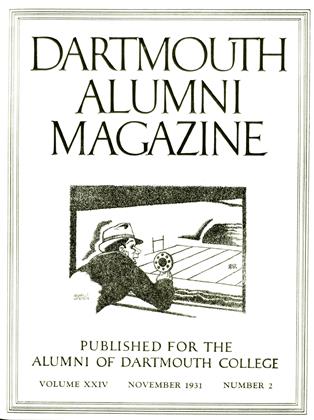By E. Bradlee Watson and Benfield Pressey. Charles Scribner's Sons. 1931.
Another collection of plays is on the market, but fortunately for people interested in the drama Professor Watson's and Pressey's "Contemporary Drama" is more than just another collection of plays. It is a distinct contribution to the study of the development of modern drama.
The anthology is in seven volumes, each volume containing five plays. There is one volume of American plays, two volumes of English and Irish plays, and four volumes of European plays.
In selecting plays for their collection, Professors Watson and Pressey have chosen plays of outstanding merit in relation to the period they represent and have shown the influence these plays and their authors had on their contemporaries and the playwrights who followed them. For example, in the volume of American plays, the first play, Mitchell's "The New York Idea" is a splendid example of the Early Realistic school of playwriting in America. This is followed by O'Neill's "The Emperor Jones" which has both Realistic and non-Realistic qualities. The next two plays, "Processional" by Lawson and Kaufman and Connelly's "Beggar On Horseback" are frankly non-Realistic, showing the development of the Expressionistic school of playwriting. The last play is Howard's "The Silver Chord" which is an example of the modern school of Realism in the theater.
In the two volumes of English and Irish plays one gets a great variety of style and subject matter, ranging from Pinero's "Mid-Channel" to O'Casey's "Juno and the Pay- cock." And for the first time to my knowledge a Barrie play and a Galsworthy play appear in a collection. "What Every Woman Knows" and "Justice" would in themselves make these two volumes worth while. The period from 1900 to the present time is one of the bright spots in the history of the English and Irish theaters, and the plays in these two volumes are excellent representatives of this period.
The four volumes of European plays begin with Ibsen's "A Doll's House," which is followed by "The Vultures" by Becque and "The Fossils" by de Curel, who, being influenced by Ibsen, wrote plays which led to the development of the French Naturalistic school. Examples of plays of the Romantic school are found in Materlinck's "Pelleas and Melisande" and Rostand's "Cyrano de Bergerac." The Russian Realistic school is represented by three plays of Chekhov, "Uncle Vanya" "The Sea Gull," and "The Cherry Orchard." Interesting examples of European Expressionism are found in Toller's "Man and the Masses" and Capek's "R.U.R." There are too many to consider each one. Suffice it to say that practically every country in Europe is represented with outstanding plays by one or more of its great dramatists.
The notes which precede each play give illuminating facts about the author, his place in the development of contemporary drama, and interesting material about the production of the play: the style in which it was produced and how this style influenced the development of the newer styles in the theater. They form an excellent resume of the development of modern dramatic literature and production. A very complete bibliography, both general and specific, found in the front of each volume, opens to the student worlds of material on the dramatists and production methods of the plays contained in that volume.
"Contemporary Drama" was compiled primarily for use in the teaching of modern drama and, as such, I know of nothing that can equal it. The volumes are very nicely bound pocket-size editions with good-sized type, easy to handle and to read. The notes and bibliographies come before each play and not in an appendix as they usually do in anthologies. The books having been designed for classroom use it is pleasing to see how little they resemble text-books in appearance. They will make an attractive and worth while addition to anyone's library.
Speaking adversely, one might wish that one volume of European plays could be dropped and a second volume of American plays put in its place. But when one realizes the stone wall of copyright which faces the person who undertakes to compile an anthology of plays, he will be thankful for the number of truly great plays which "Contemporary Drama" contains, many of them not to be found in any other collection.
Thank you, Professors Watson and Pressey, for publishing an anthology that does not remind one, every time he picks it up, of Funk and Wagnalls Standard Dictionary, or the Encyclopedia Britannica.
 View Full Issue
View Full Issue
More From This Issue
-
 Article
ArticleThe Class of Nineteen Thirty-five
November 1931 By E. Gordon Bill -
 Sports
SportsFootball at Dartmouth in the Year 1931
November 1931 By Sidney C. Hayward -
 Class Notes
Class NotesCLASS of 1910
November 1931 By "Hap' Hinman -
 Class Notes
Class NotesCLASS of 1930
November 1931 By Albert I. Dickerson -
 Class Notes
Class NotesCLASS of 1926
November 1931 By J. Branton Wallace -
 Class Notes
Class NotesCLASS of 1929
November 1931 By Frederick William Andres
Warner Bentley
Books
-
 Books
BooksAT THE CROSSROADS.
OCTOBER 1965 By CLIF JORDAN '45 -
 Books
BooksALUMNI PUBLICATIONS
April, 1923 By F. E. BROWN. -
 Books
BooksECONOMIC BOTANY
June 1952 By F.S. PAGE '13 -
 Books
BooksAttentive Eye, Attentive Ear
November 1983 By Peter Smith -
 Books
BooksALUMNI PUBLICATIONS WHAT MAKES SAMMY RUN
April 1941 By Sidney Cox -
 Books
BooksSUCCESSFUL HANDLING OF LABOR GRIEVANCES.
June 1956 By WAYNE G. BROEHL JR.






